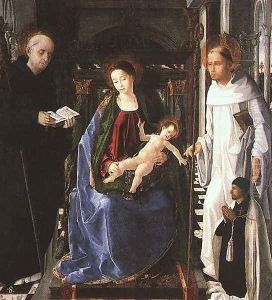Pablo de San Leocadio Paintings
Pablo de San Leocadio, also known as Paolo da Reggio, was an Italian Renaissance painter who was born around 1447 in Reggio Emilia, Italy. Not much is known about his early life or training, but he is recognized for his contributions to the Spanish Renaissance, particularly after he moved to Spain in the latter half of the 15th century.
San Leocadio's style is often seen as a fusion of Italian Renaissance characteristics with Spanish artistic traditions. After his relocation to Spain, he became associated with the court of Ferdinand II of Aragon and Isabella I of Castile, the Catholic Monarchs whose reign saw the completion of the Reconquista and the beginning of Spanish colonization of the Americas.
One of his notable works is the altarpiece of the Cathedral of Valencia, which he painted in collaboration with the Spanish painter Rodrigo de Osona. This work showcases his ability to blend the detailed narrative style typical of Italian painting with the rich colors and textures preferred in Spanish art of the time.
Pablo de San Leocadio's influence was significant in the spread of Italian Renaissance styles into Spain. His works are characterized by their delicate treatment of figures, a balanced use of space, and a clear narrative structure. San Leocadio's art served as a bridge between the Italian and Spanish schools of painting, which would flourish into the distinctive style of the Spanish Renaissance.
There is limited information regarding the later years of his life. Documentation suggests that he remained active in Valencia, Spain, until his death around 1520. His legacy endures through his contributions to the cultural exchange between Italy and Spain and his role in the development of the Spanish Renaissance. His works remain important examples of the cross-pollination of artistic ideas across Europe during this period.
